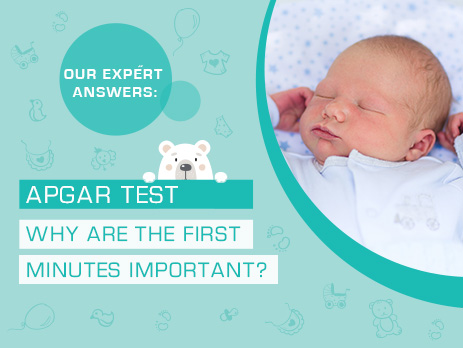Your Baby’s First Minutes – The Importance of the Apgar Test
IN THIS ARTICLE:
What is the apgar test and why is it important?
Explanation of the 5 parameters
Evaluating and understanding Apgar scores
How to support babies born with a low Apgar score
The Apgar test is one of the first assessments performed on newborns to evaluate their overall condition immediately after birth. In this blog post, Dr. Tibor Kovács, an experienced neonatologist and pediatrician, helps us understand the significance of this test.
What is the Apgar test and why is it important?
The Apgar test is an objective assessment used to evaluate a newborn’s overall condition. It examines five key parameters at one, five, and ten minutes after birth. This test plays a crucial role in the early care of newborns, helping healthcare professionals identify any immediate interventions that may be necessary.
The 5 parameters of the Apgar test
- Breathing (Respiration): Evaluating the baby’s breathing is crucial, as the newborn must transition from intrauterine to independent respiration. A strong, rhythmic cry indicates well-developed lungs and healthy respiratory function, while weak or irregular breathing may suggest difficulties.
- Heart rate (Pulse): The newborn’s heart rate reflects the condition of their circulatory system. A higher pulse rate (above 100 beats per minute) is a positive sign, indicating proper heart function.
- Skin color (Appearance): Assessing skin color (pink, pale, or bluish) helps determine oxygenation and circulation. A completely pink baby suggests good oxygen supply and a well-functioning circulatory system, while bluish extremities may indicate oxygenation issues.
- Muscle tone (Activity): This parameter assesses how active and mobile the newborn is. Healthy babies exhibit spontaneous movements and flexed limbs. Low muscle tone might indicate underlying issues, so doctors check for muscle stiffness and responsiveness.
- Reflex irritability (Grimace response): Reflexes measure neurological function and responsiveness to stimuli. Strong reactions, such as coughing, sneezing, or crying in response to stimulation, indicate a well-functioning nervous system. Weak or absent reflexes may signal concerns requiring further evaluation.
The evaluation and significance of the Apgar test
The test results allow doctors to quickly assess whether special care or intervention is needed. A high score (8-10 points) indicates that the baby is adapting well to the new environment, while a lower score may require immediate medical attention. Each parameter is scored 0, 1, or 2 points, and if the baby’s total score is between 8-10, it means their adaptation ability is completely normal, requiring no further intervention. If the score is lower, the baby may have a temporary minor adaptation issue. In most cases, physical stimulation, such as gentle rubbing, helps improve vital functions. However, if the Apgar values fall into the lower range, the baby may require intensive care, including assisted ventilation or resuscitation.
How can we help babies born with a low Apgar score?
Dr. Tibor Kovács shares insights on the types of care needed for babies born with a low Apgar score, ranging from physical stimulation to intensive medical interventions, including hypothermia treatment, which aims to reduce the extent of oxygen deprivation damage.
To minimize damage, neonatal care has incorporated hypothermia treatment, where the baby is cooled to reduce the cells’ basic oxygen demand, thus preventing further harm. If the newborn’s central nervous system is severely affected by oxygen deprivation, early examinations can detect lasting neurological injuries and paralysis, which may require long-term rehabilitative care.
However, there are milder cases of oxygen deprivation that can lead to developmental differences later in life, manifesting as learning difficulties, memory issues, or even behavioral disorders. The most crucial factor is minimizing oxygen deprivation during birth, and if signs of it appear, prompt and professional intervention is essential.





